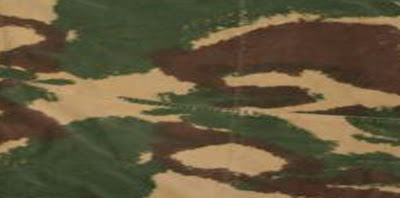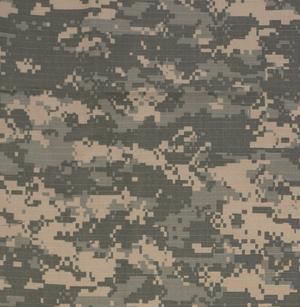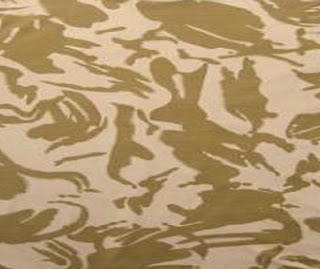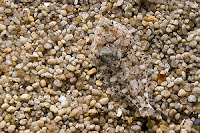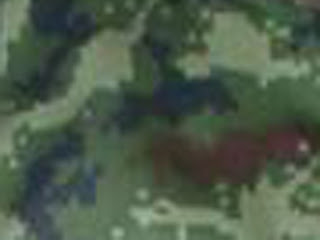ลายพราง:ACU MARPAT
นำมาใช้:2005
ปรากฏในสงคราม:อิรัก อัฟกานิสถาน
ประเทศที่ออกแบบ:สหรัฐอเมริกา
ลายพรางประกอบไปด้วยสี 3 สี: เทา เทาอ่อน ครีม
ลายพรางนี้คือลายพรางที่มีชื่อเสียงมากติดอันดับต้นๆของโลกและนิยมเล่นในหมู่ชาวบีบีกัน
และแทนที่ลายพราง Woodland ได้ในที่สุด
he
Army Combat Uniform (
ACU) is the current
combat uniform worn by the
United States Army. It is the successor to the
Battle Dress Uniform (BDU) and
Desert Camouflage Uniform (DCU) worn during the 1980s and 1990s.
[1]
It features a number of design changes, as well as a different
camouflage pattern from its predecessor. The ACU and its component
materials are manufactured by the existing industrial infrastructure
which produced the now-obsolete BDU. ACU's are made of 50% nylon and 50%
cotton. All other blends are not official issue.
[2]
[edit] Patterns

ACU in the Universal Camouflage Pattern and its replacement Multicam pattern (2nd from left) in Afghanistan, 2011.
[edit] Universal Camouflage Pattern
The U.S. Army uses the
Universal Camouflage Pattern (UCP), which blends tan, gray and green (Desert Sand
500, Urban Gray 501 and Foliage Green =
http://kitup.military.com/2009/12/camouflaging-yourself-and-equipment.html}} Pure black, when viewed through
night vision devices, appears excessively dark and creates an undesirable high-contrast image.
[edit] MultiCam / OEF Enduring Freedom Camouflage Pattern
|
|
This section may need to be updated.
Please update this section to reflect recent events or newly available
information, and remove this template when finished. Please see the talk page for more information. (January 2011) |
Soldiers deployed to Afghanistan (starting with the
173rd Airborne Brigade) are issued a version of the "
MultiCam" pattern.
[3]
Beginning in late 2010, all Soldiers deploying in support of Operating
Enduring Freedom are issued flame resistant ACU's in Operation Enduring
Freedom Camouflage Pattern (OCP). These uniforms are designed to prevent
third-degree burns and up to 30 percent of second degree burns.
Additionally, the uniforms are treated with the chemical permethrin to
help protect Soldiers from insect-borne diseases like malaria.
[edit] Components
The uniform features
hook-and-loop fasteners ("velcro") on the pockets.
 |
|
 |
IR tab closed ( left) and opened ( right)
|
The cost to each soldier is $76 per uniform, compared to $58 for a
BDU,
but clothing allowances in soldiers' pay have been adjusted to
compensate for the increased cost. Insignia and tags, such as name and
branch tapes, are extra purchases. Uniforms purchased from commercial
websites and surplus stores that sell to the general public do not
include the
IR squares, which are restricted to military personnel because of their sensitive nature.
[edit] Jacket

U.S. Army soldier in Kunar Province, Afghanistan.

Soldier wearing the 10th Mountain Division Shoulder Sleeve Insignia.
The ACU jacket uses hook-and-loop-backed attachments to secure items such as name tapes,
rank insignia, and shoulder patches and tabs, as well as recognition devices such as the American flag patch and the infrared (IR) tab.
Near Infrared (NIR) Signature Management Technology is incorporated to minimize the infrared silhouette. Permanent IR
IFF squares are sewn to each shoulder to help identify friendly personnel when
night vision devices are used, and are protected by Velcro tabs in
garrison or when not in use.
Three U.S. flag insignia are authorized for wear with the ACU:
full-color, full-color IR, and subdued IR. The U.S. flag insignia
(full-color or subdued) is worn on the right shoulder pocket flap of the
ACU coat. The subdued version is only worn as directed under tactical
or field conditions.
[4]
On the right shoulder of the ACU, the U.S. flag is depicted with the
union (stars) to the viewer's right, instead of the usual left (flag's
own right); this is to give the impression of the flag moving forward
with the wearer. Subdued
shoulder sleeve insignia are always worn.
The jacket's
Mandarin collar is worn up in combat to fit with the
Improved Outer Tactical Vest
(IOTV) body armor, and worn in the down position otherwise. The front
closure is zippered and reinforced with velcro, designed for use with
OTV. The tilted chest pockets, cuffs, and elbow pad insert pockets also
utilize hook-and-loop closure. There is a three slot pen pocket on the
left arm of the jacket, and blouse bellows for increased mobility.
Only pin-on skills badges are authorized for wear on the ACU, and no more than 5 may be worn at any one time.
[5] Skills tabs, such as the
President's Hundred Tab,
Special Forces,
Ranger, and
Sapper are worn on the left sleeve pocket flap, and are subject to a 3-tab-only rule.
[6] A tab that is an integral part of a unit patch, such as the "Mountain" or "Airborne" tab, is not counted against the rule. The
U.S. Army Chaplain insignia
is the only authorized branch insignia to be worn on the ACU. It is
centered 1/8 inch above the right name tape. The insignia may be the
metal pin-on variety or the black embroidered insignia on digitized
fabric with hook and loop (velcro) fasteners.
[7]
Current regulations require the jacket to not extend below the top of
the cargo pocket and not be higher than the bottom of the side pocket.
Sleeves are to be worn down at all times, in contrast with the earlier
Army BDU policy which authorized sleeve-folding for the summer uniform.
In the field, the jacket may be replaced by the flame resistant
Army Combat Shirt when worn directly under the IOTV.
[8]
[edit] Trouser
The ACU trouser (or ACU pant) is worn with a two-inch nylon web belt,
and features Velcro pouches for knee pad inserts, two forward-tilted
thigh storage pockets with elastic drawstring and Velcro for closure
during movement, and two calf storage pockets one on each pant leg with a
Velcro closure. In addition, the pants legs can be bloused and must not
extend past the third eyelet of the boots as per AR 670-1. Army Combat
trousers with flame resistant materials are being issued for use in Iraq
and Afghanistan.
[8]
[edit] Headgear
Typically, the ACU is worn with the
Advanced Combat Helmet, a
patrol cap, or a
boonie hat as appropriate. The
patrol cap
is a straight-sided, flat-topped soft cap, with a double thick bill and
internal pocket. When in garrison, the maroon, tan, and green berets
may be worn by
paratroopers,
Army Rangers, and
Army Special Forces
respectively. The foliage green or black micro fleece cap or a black
knit cap is authorized in cold climates. The fleece cap may be folded
with a 1-2" fold though it may not ever be rolled.
[9]
(This is not included in the attached ALARACT. It refers to wear with
the IPFU only). The name tape is worn on the back of the patrol cap.
Sew-on rank is recommended but pin-on rank is authorized on the ACU
Patrol Cap and ACU Boonie Hat. The MICH (Modular Integrated
Communications Helmet) Camouflage cover rank must be sewn on if worn but
is often not used as the
night vision device mount would obstruct it.
[edit] T-Shirt
The ACU is worn with a moisture-wicking sand colored
T-shirt.
[10] A Foliage Green T-shirt, which is 100%
cotton,
has been authorized for wear by select soldiers and for some training
environments or deployed soldiers; authorized environments include Iraq,
Afghanistan and Korea. Black T-shirts are authorized for wear by
certain instructors on Army posts (Ranger School, Sapper, Airborne,
Jumpmaster, Pathfinder, Sniper etc.).
The ACU is worn with tan
Army Combat Boots
and moisture wicking socks. Commercial versions of this boot are
authorized without limitation, complying with the following
regulations — be at least 8 inches in height, be made of tan rough side
out cattle hide leather with a plain toe and tan rubber outsoles, and be
without zippers, metal cleats, or side tabs.
[11] The
Mountain Combat Boot is available for difficult terrain,
Extreme Cold Vapor Barrier Boots for cold weather, and the
Modular Boot System is being developed to replace the ACB.
[edit] Uniform care

A Sailor attached to an Army unit in Iraq displays his ACU.
Although common practice (though not required by regulation) with the
BDUs, ACUs are not to be starched. As per the ALARACT message in effect
until a new revision of AR 670-1 is released, "Soldiers will not starch
the Army Combat Uniform under any circumstances. The use of starch,
sizing, and any process that involves dry-cleaning or steam press will
adversely affect the treatments and durability of the uniform and is not
authorized."
[11]
Starching the uniform has been shown to cause discoloration. It
enhances the IR signature, making the uniform inappropriately bright
under night vision viewing.
Personnel have been instructed that the uniform must be washed with a mild detergent that does not contain "
optical brighteners."
Detergents with optical brighteners may cause discoloration of the
uniform, which would nullify the purpose of the very specific camouflage
design and result in possible unwanted detection of personnel using the
uniforms in combat. Some detergents have phosphorescent properties
which enhance an enemy's ability to see the soldier when viewed with
night vision devices.
Soldiers have expressed concern about the velcro on the ACU. Dirt and
mud can clog the hooks and loops or they can wear out with use,
requiring the use of cleaning brushes for clearing the velcro as part of
daily maintenance.
[12]
Zippers have also been a topic of concern. Soldiers also express
concern because the zippers (as with any zipper) can bind up, and render
the uniform uncomfortable to wear, especially with
Body Armor.
According to the Program Executive Office Soldier "Commercial Velcro
will be sold in clothing sales for the repair/replacement of Velcro.
Additionally soldiers have been using the small weapons cleaning brush
to clean out any sand and dirt from the pile and it has been working
very well."
[11]
As of 2010, Velcro will be phased out in favor of buttons, which are
silent, work well in dust, mud and snow, support heavier use and hold
more securely.
[13]
[edit] Initial fielding
The process of replacing the Army's
Woodland (in use since 1981) and
Three Color Desert pattern BDU and
DCU
with the ACU was to begin in April 2005; however, the process began two
months earlier through the Rapid Fielding Initiative. Soldiers from the
48th Infantry Brigade Combat Team
were the first Army unit, active or reserve, to receive the ACU,
subsequently deploying the entire Brigade into OIF combat in May 2005.
Initial reception of the ACU was mixed, with complaints of insufficient
durability and excessive maintenance.
[12] The use of multiple camouflage patterns within an organization is now seldom seen, as the ACU has been widely fielded.
[citation needed]

